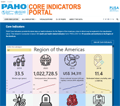
Martinique - Profile
The Health in the Americas+ country profiles are based on the interagency indicators available as of the dates referenced. The sources are referenced in this table. In some cases, the values of the indicators may differ from the most recent data available in the country.
Environmental and social determinants of health
In 2000 the total population of Martinique was 432 543 inhabitants; by 2023 this figure had risen to 366 981, representing a 15.2% decrease. Regarding the country’s demographic profile, in 2023 people over 65 years of age accounted for 23.5% of the total population, an increase of 13.5 percentage points compared to the year 2000. In 2023, there were 117.3 women per 100 men and 150.6 older people (65 years or older) per 100 children under 15 years of age, as can be seen in the country’s population pyramids, distributed by age group and sex (Figure 1). Considering the population between 15 and 64 years of age to be potentially active (i.e., potential participants in the labor force), this group represented 60.9% of the total population of the country in 2023 (223 626 people). When we add these figures to the potentially passive population (57 194 under 15 years of age and 86 162 over 65 years of age), the result is a dependency ratio of 64.1 potentially passive people per 100 potentially active people. This ratio was 52.6 in 2000.
Life expectancy at birth in 2023 was 83.4 years, higher than the average for the Region of the Americas and 5.7 years higher that in 2000.
Figure 1. Population pyramids, years 2000 and 2020
The literacy rate in Martinique was 96.9% in 2014. Among men, this indicator amounted to 98.0%, while among women it was 96.1%.
Health situation
Maternal and child health
Between the years 2010 and 2019, infant mortality decreased from 9.3 to 7.2 per 1 000 live births. This represents a decrease of 22.6%. The proportion of low-birth-weight births (<2,500 grams) increased from 10.4% to 12.3% between the years 2003 and 2011.
In relation to fertility, it is estimated that in 2023 women had an average of 1.9 children throughout their reproductive lives. In the specific case of adolescent fertility, there was a 64.5% decrease, from 30.1 live births per 1000 women aged 15 to 19 years in 2000 to 10.7 in 2023. In 2012, 99.9% of births were attended by skilled birth personnel.
Communicable diseases
The rate of new HIV diagnoses per 100 000 population was estimated at 12 for the year 2019.
Status of the COVID-19 Pandemic
In Martinique in 2020, there were a total of 6 091 cases of COVID-19, representing 16 511 per million population. In 2021, there were 43 914 identified cases, equivalent to 119 041 per million population. In 2022, there were 169 524 identified cases, equivalent to 459 542 per million population. In 2020, there were 43 deaths directly caused by COVID-19 in people diagnosed with the disease, or 117 per million population; in 2021, 741 deaths were reported, or 2 009 per million. In 2022, 252 deaths directly caused by COVID-19 in people diagnosed with the disease, or 683 per million population. In 2020, Martinique ranked 32th in the Region of the Americas in terms of the number of deaths from COVID-19, and 6th in 2022, with a cumulative 2808 deaths per million population over the considered years (Figure 2).
By December 31, 2021, 39.5% of the country's population had at least one dose of COVID-19 vaccine applied, and by April 20, 2022 (latest available data), 38% of the population was fully vaccinated.
Figure 2. Cumulative COVID-19 deaths in the Region of the Americas, to July 29th, 2023
The sources of the interagency indicators used in this profile can be found in this table.
 For the latest data on health indicators for the Region of the Americas, be sure to visit the PAHO Core Indicators portal.
For the latest data on health indicators for the Region of the Americas, be sure to visit the PAHO Core Indicators portal.
COUNTRY/TERRITORY PROFILES
Anguilla
Antigua and Barbuda
Argentina
Aruba
Bahamas
Barbados
Belize
Bermuda
Bolivia
Bonaire, Sint Eustatius, and Saba
Brazil (English) (Português)
Canada
Cayman Islands
Chile
Colombia
Costa Rica
Cuba
Curaçao
Dominica
Dominican Republic
Ecuador
El Salvador
French Guiana, Guadeloupe and Martinique
Grenada
Guatemala
Guyana
Haiti (English) (Français)
Honduras
Jamaica
Mexico
Montserrat
Nicaragua
Panama
Paraguay
Peru
Puerto Rico
Saint Kitts and Nevis
Saint Lucia
Saint Vincent and the Grenadines
Sint Maarten
Suriname
Trinidad and Tobago
Turks and Caicos Islands
United States of America
Uruguay
Venezuela
Virgin Islands (British)
Virgin Islands (U.S.)


